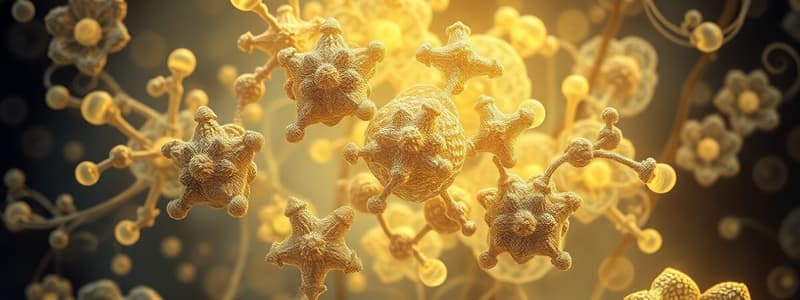Podcast
Questions and Answers
What structural feature distinguishes fatty acids in terms of saturation?
What structural feature distinguishes fatty acids in terms of saturation?
- The number of hydroxyl groups
- The presence of double bonds (correct)
- The type of fatty acid backbone
- The length of the carbon chain
Which lipid plays a crucial role in cell membrane structure and is a precursor for steroid hormones?
Which lipid plays a crucial role in cell membrane structure and is a precursor for steroid hormones?
- Phospholipids
- Fatty acids
- Cholesterol (correct)
- Triglycerides
High levels of which lipoprotein are associated with an increased risk of heart disease?
High levels of which lipoprotein are associated with an increased risk of heart disease?
- IDL
- HDL
- VLDL
- LDL (correct)
What is the primary function of phospholipids in biological systems?
What is the primary function of phospholipids in biological systems?
During lipid metabolism, triglycerides are primarily broken down into which products?
During lipid metabolism, triglycerides are primarily broken down into which products?
Which condition is characterized by the hardening and narrowing of the arteries due to high lipid levels?
Which condition is characterized by the hardening and narrowing of the arteries due to high lipid levels?
What is a common consequence of having low levels of HDL cholesterol?
What is a common consequence of having low levels of HDL cholesterol?
Which part of the body plays a pivotal role in synthesizing and processing lipids?
Which part of the body plays a pivotal role in synthesizing and processing lipids?
Flashcards
Triglyceride Structure
Triglyceride Structure
Triglycerides are esters of glycerol and three fatty acids, which can be saturated, monounsaturated, or polyunsaturated.
Sterol Role
Sterol Role
Sterols, like cholesterol, have a four-ring structure vital for cell membranes, steroid hormones, and bile acids.
Atherosclerosis
Atherosclerosis
A disease where artery walls harden and narrow due to high levels of cholesterol & triglycerides.
Lipid Transportation
Lipid Transportation
Signup and view all the flashcards
LDL Cholesterol
LDL Cholesterol
Signup and view all the flashcards
HDL Cholesterol
HDL Cholesterol
Signup and view all the flashcards
Lipid Metabolism
Lipid Metabolism
Signup and view all the flashcards
Phospholipid Function
Phospholipid Function
Signup and view all the flashcards
Study Notes
Triglycerides Structure
- Triglycerides are esters of glycerol and three fatty acids.
- Fatty acids can be saturated (no double bonds), monounsaturated (one double bond), or polyunsaturated (more than one double bond).
- Saturated fatty acids are typically solid at room temperature, while unsaturated fatty acids are liquid.
- Triglycerides are the primary form of fat storage in the body.
- They provide a concentrated source of energy.
Sterols Role In The Body
- Sterols are a class of lipids characterized by a four-ring structure.
- Cholesterol is the most common sterol in animals.
- Cholesterol is essential for cell membrane structure and function.
- It's also a precursor for steroid hormones (e.g., estrogen, testosterone, cortisol) and bile acids.
- Cholesterol is transported in the blood by lipoproteins (LDL, HDL).
Lipid-related Diseases
- High levels of triglycerides and cholesterol in the blood can contribute to atherosclerosis (hardening and narrowing of the arteries).
- Atherosclerosis increases the risk of heart disease and stroke.
- Different types of lipoproteins transport lipids throughout the body.
- Excess LDL ("bad") cholesterol deposits in artery walls, leading to plaque buildup.
- High LDL levels increase the risk of heart disease.
- Low HDL ("good") cholesterol levels decrease the body's ability to remove cholesterol from the arteries.
- High triglycerides are also associated with cardiovascular risk, even independently.
- Some genetic conditions can cause abnormal lipid levels and increase susceptibility to lipid-related diseases.
Lipid Metabolism
- Lipid metabolism involves the processes of lipid digestion, absorption, transport, and utilization.
- Triglycerides are broken down into fatty acids and glycerol in the small intestine.
- Fatty acids are absorbed into the lymphatic system and transported to the bloodstream.
- Lipoproteins transport lipids throughout the body.
- Excess dietary lipids are stored as triglycerides in adipose tissue.
- The body uses fatty acids for energy production through beta-oxidation.
- The liver plays a crucial role in lipid metabolism by synthesizing and processing lipids.
Phospholipids Function
- Phospholipids are a major component of cell membranes.
- They have a hydrophilic (water-loving) head and two hydrophobic (water-fearing) tails.
- This structure allows them to form a lipid bilayer, the basic structure of cell membranes.
- Phospholipids regulate the fluidity and permeability of cell membranes.
- They also play a role in signal transduction, cell recognition, and other cellular processes.
- Specific phospholipids have specialized roles in cell signaling and membrane function.
- Some phospholipids are crucial for maintaining membrane integrity and fluidity under different cellular and environmental conditions.
Studying That Suits You
Use AI to generate personalized quizzes and flashcards to suit your learning preferences.




